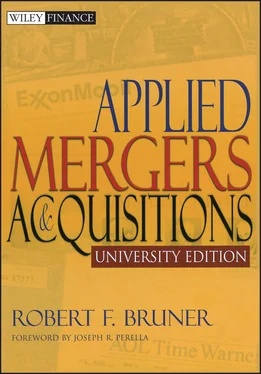Source of data: Rumelt (1974), page 91.
Value Drivers in Diversification and Focus
Numerous hypotheses about the profitability of diversification and focus boil down to two lines of argument:
EFFICIENCY (OR INEFFICIENCY) OF INTERNAL CAPITAL MARKETSThe diversified firm internalizes the capital market by acting as an allocator of resources among businesses in the portfolio. Advocates of diversification claim that the closer proximity to the companies and access to better information about them permits the internal capital market to operate more efficiently than external markets. Advocates of focus argue that behavioral and agency considerations intervene to make the internal capital markets less efficient; people avoid unpleasant decisions about starving or selling unprofitable businesses and therefore tend to subsidize poorly performing units from the resources of high-performing units. Four papers 7 make the basic argument for efficiency of internal capital markets. Also, Matsusaka and Nanda (1996) have argued that the internal capital market creates real option value for the firm by virtue of the strategic investment flexibility it affords.
COSTS OF INFORMATION AND AGENCYMultidivisional firms are complicated to understand; investors require considerable information to value these firms. Yet most diversified firms provide no more information about their operations than do more focused firms. This opacity creates an asymmetry of information that might cause investors to discount the value of diversified firms more than focused firms. Also, the opacity shelters managers of diversified firms from the scrutiny and discipline of capital markets, creating the threat of agency costs and the manager’s expropriation of private benefits. This, too, leads to lower profitability. Scharfstein and Stein (2000) and Rajan, Servaes, and Zingales (2000) argued that unrelated diversification is inefficient and is a result of agency costs. Cross subsidization of business units within the firm is inefficient. Agency costs appear principally in efforts by managers to reduce risk of the firm out of self-interest only, and extract private benefits of control.
Summary of Research Findings
Studies of the economic impact of diversification or focus approach the question from among six methodologies. Each approach lends a different perspective and has its peculiar strengths and weaknesses. As with the general summary of the profitability of M&A (see Chapter 3), the findings lend no ironclad conclusions. Rather, one needs to look for tendencies. In general terms, here is a breakdown of the research approaches and their findings.
EVENT STUDIESA number of papers consider the differences in return associated with the announcement of diversifying or focusing acquisitions, divestitures, spin-offs, and carve-outs. If diversification pays, it should be reflected in higher returns for acquisitions and disposals that result in a more diverse business portfolio for the firm. If focusing pays, announcements that herald acquisitions or disposals that will focus the firm should result in higher returns. The event study approach has the strength of focusing on investor reactions and on market prices. The weaknesses stem from possible noise in the market from conflicting events and questions about market efficiency.
Acquisitions. Seven studies 8 find cumulative average residuals (CARs) at the announcements of transactions are significantly more negative for diversifying deals than for focusing deals. These studies suggest that mergers that focus the firm enhance the buyer’s share value by 1 to 3 percent more than diversifying deals. Yet six other studies 9 show significantly positive CARs for diversifying acquisitions. Most of these, however, are studies of conglomerate acquisitions in the 1960s (e.g., Hubbard and Palia 1999) or are associated with the relaxation of regulatory constraints on diversifying acquisitions (e.g., Carow 2001). On balance, the event studies of acquisition announcements suggest that focus pays more than diversification.
Joint ventures and alliances. Three studies consider the effect of focusing or diversifying JVs. Ferris et al. (2002) find focus-increasing JVs show materially larger CARs than diversifying JVs. Chan et al. (1997) report that horizontal alliances involving technology transfer have a materially higher CAR. And Gleason et al. (2003) find that horizontal deals in the financial services industry have materially higher CARs than diversifying deals. The event studies of JV and alliance announcements suggest that focus pays more than diversification.
Divestitures, spin-offs, and carve-outs. Generally, divestitures, spin-offs, and carve-outs are good news for investors: Since these deals shed assets, the results would seem to be roughly supportive of focusing. But what matters is the nature of the assets being disposed. Two studies of carve-outs reported in Exhibit 6.18suggest a materially larger announcement CAR when the carved-out unit is not from an industry related to the parent’s core business (Hurlburt et al. 2002; Vijh 2000). Three studies of spin-offs in Exhibit 6.17show a materially larger announcement CAR when the transaction is focus-increasing (Veld and Veld-Meruklova 2002; McNeil and Moore 2001; Johnson et al. 1996). Regarding divestitures, Donaldson (1990) reports materially larger positive CARs at the announcement of sale of noncore assets compared to core asset sales. Dittmar and Shivdasani (undated) report that over the year following the divestiture, firms that became single-business firms had a 3 percent higher return than those that remained diversified. In short, the event studies of divestitures, spin-offs, and carve-outs are consistent with benefits from focusing and penalties from diversification.
Q TESTS Tobin’s Q is a measure of economic efficiency estimated as the ratio of the market value of assets divided by book value. The higher the Q, the higher is efficiency. Typically, these studies regress Q against a variety of independent variables, including measures of diversification and focus. Four studies give findings consistent with the benefits of focus. Lang and Stulz (1994) find that diversified firms have lower Qs than single-business firms. Morck and Yeung (1998) find that diversification is associated with lower Q except where the industry is information-intensive. Aggarwal and Samwick (2003) report that diversification has a significantly negative effect on Q.
EXCESS VALUE STUDIES: TESTS FOR A DIVERSIFICATION DISCOUNTA logical test of the impact of diversification on value is to compare the actual market value of the firm with its “sum of the parts” value, where each part of the firm is valued at multiples consistent with industry peers. The “excess value” of a diversified firm is simply the difference between actual and imputed values. Nine studies 10 find negative excess values for diversified firms, in the range of 8 to 15 percent—this is the famous “diversification discount” 11 that is often cited in debates over the unprofitability of diversification. On the basis of these findings Lamont and Polk (2002, page 75) asserted, “Diversification destroys value.” Yet, more recent studies have challenged the size and even the existence of the diversification discount. The line of attack is that certain data sources contain an inadvertent bias in favor or the diversification discount and that many of the units acquired by diversified firms were already discounted before their acquisition—this means that the existence of a discount has little to do with a strategy of diversification. Finally, some studies use more granular data arguing that business segments are too large to capture the costs or benefits of diversification. Nine studies 12 report no discount, or even a diversification premium using these revised research approaches. If one believes in the power of the newer techniques, the excess value studies would suggest that diversification has a neutral or positive effect on value.
Читать дальше












